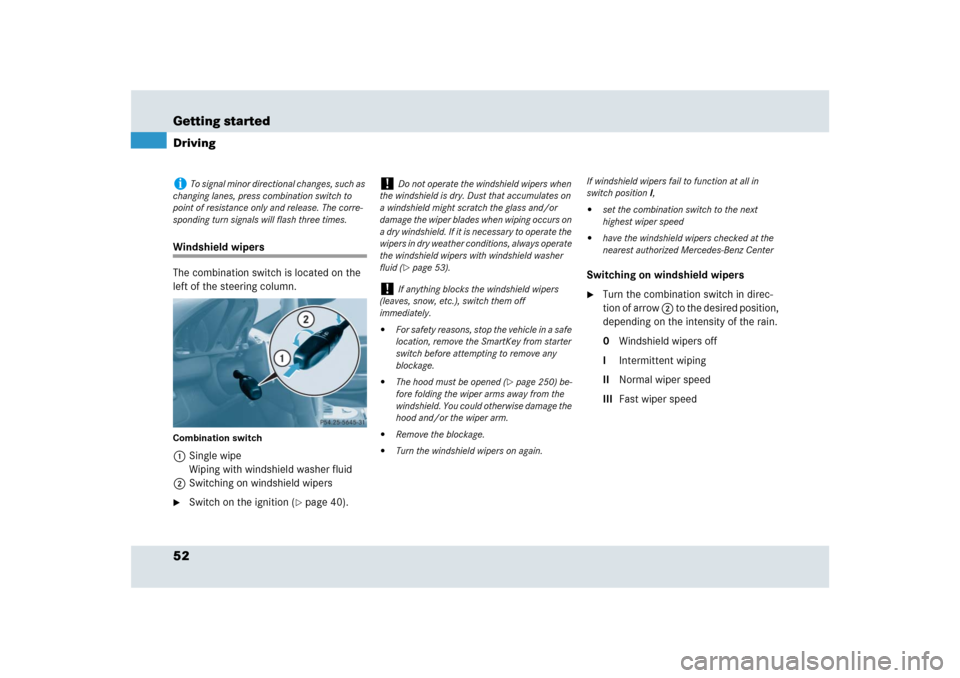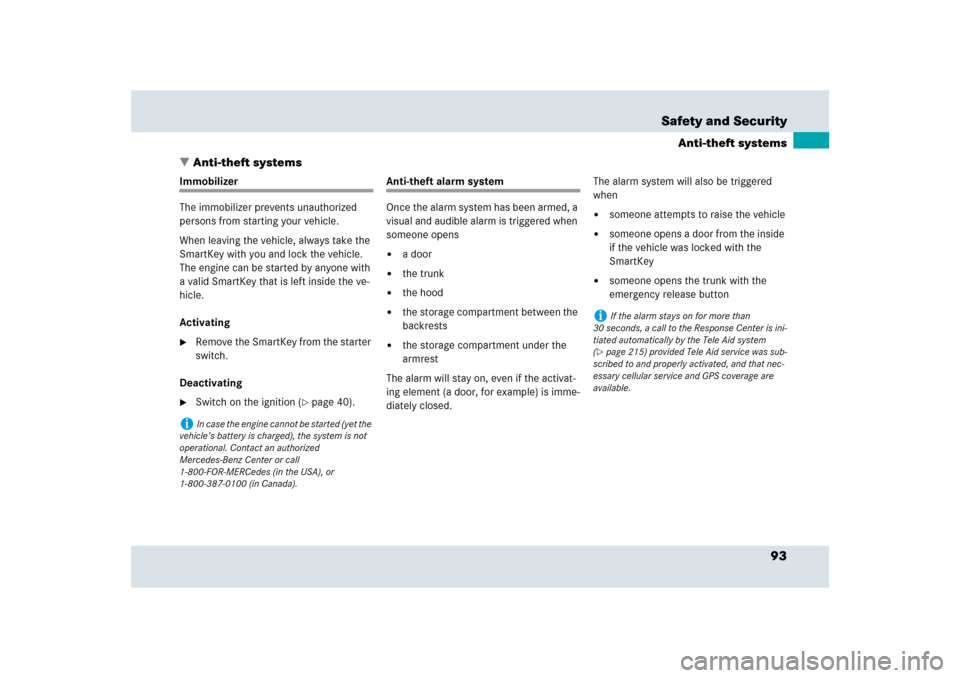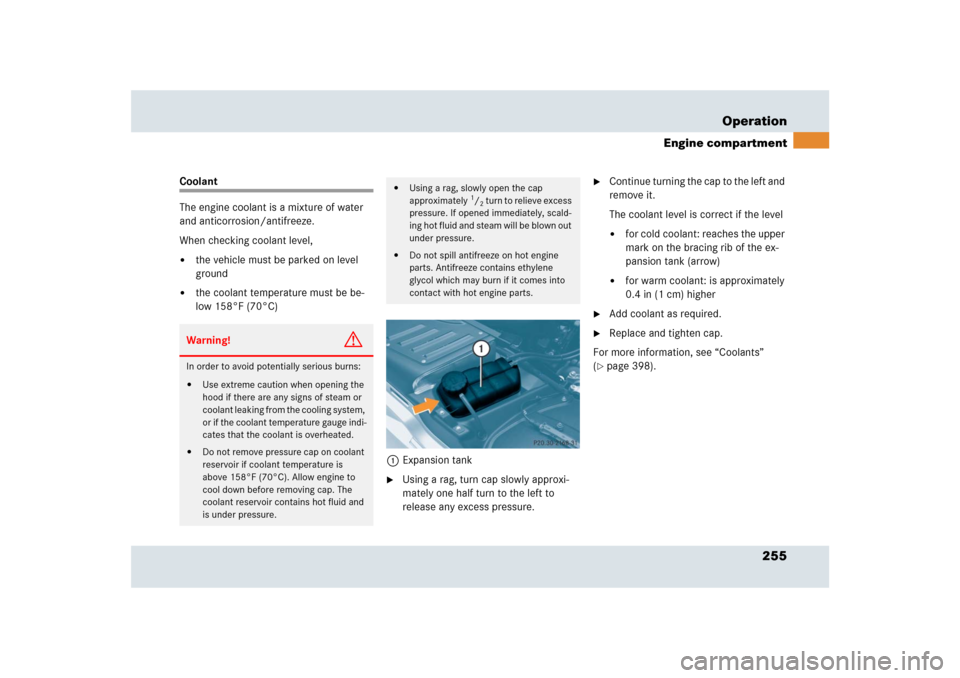Page 27 of 426
27 At a glance
Cockpit
Item
Page
1
Cruise control lever
205
2
Steering wheel gearshift
paddle
177
3
Instrument cluster
28,
114
4
Multifunction steering wheel
30,
118
5
Overhead control panel
33
6
Center console
31, 32
7
Starter switch
40
8
Horn
Item
Page
9
Headlamp washer button
181
a
Steering wheel adjustment
stalk
42
b
Hood lock release
250
c
Exterior lamp switch
51,
106
d
Combination switch�
Turn signals
�
Windshield wipers
�
High beam
51
52
110
Page 52 of 426

52 Getting startedDrivingWindshield wipers
The combination switch is located on the
left of the steering column.Combination switch1Single wipe
Wiping with windshield washer fluid
2Switching on windshield wipers�
Switch on the ignition (
�page 40).Switching on windshield wipers
�
Turn the combination switch in direc-
tion of arrow 2 to the desired position,
depending on the intensity of the rain.
0Windshield wipers off
IIntermittent wiping
IINormal wiper speed
IIIFast wiper speed
i
To signal minor directional changes, such as
changing lanes, press combination switch to
point of resistance only and release. The corre-
sponding turn signals will flash three times.
!
Do not operate the windshield wipers when
the windshield is dry. Dust that accumulates on
a windshield might scratch the glass and/or
damage the wiper blades when wiping occurs on
a dry windshield. If it is necessary to operate the
wipers in dry weather conditions, always operate
the windshield wipers with windshield washer
fluid (�page 53).
!
If anything blocks the windshield wipers
(leaves, snow, etc.), switch them off
immediately.
�
For safety reasons, stop the vehicle in a safe
location, remove the SmartKey from starter
switch before attempting to remove any
blockage.
�
The hood must be opened (
�page 250) be-
fore folding the wiper arms away from the
windshield. You could otherwise damage the
hood and/or the wiper arm.
�
Remove the blockage.
�
Turn the windshield wipers on again.If windshield wipers fail to function at all in
switch positionI,
�
set the combination switch to the next
highest wiper speed
�
have the windshield wipers checked at the
nearest authorized Mercedes-Benz Center
Page 93 of 426

93 Safety and Security
Anti-theft systems
�Anti-theft systems
Immobilizer
The immobilizer prevents unauthorized
persons from starting your vehicle.
When leaving the vehicle, always take the
SmartKey with you and lock the vehicle.
The engine can be started by anyone with
a valid SmartKey that is left inside the ve-
hicle.
Activating�
Remove the SmartKey from the starter
switch.
Deactivating
�
Switch on the ignition (
�page 40).
Anti-theft alarm system
Once the alarm system has been armed, a
visual and audible alarm is triggered when
someone opens�
a door
�
the trunk
�
the hood
�
the storage compartment between the
backrests
�
the storage compartment under the
armrest
The alarm will stay on, even if the activat-
ing element (a door, for example) is imme-
diately closed.The alarm system will also be triggered
when
�
someone attempts to raise the vehicle
�
someone opens a door from the inside
if the vehicle was locked with the
SmartKey
�
someone opens the trunk with the
emergency release button
i
In case the engine cannot be started (yet the
vehicle’s battery is charged), the system is not
operational. Contact an authorized
Mercedes-Benz Center or call
1-800-FOR-MERCedes (in the USA), or
1-800-387-0100 (in Canada).
i
If the alarm stays on for more than
30 seconds, a call to the Response Center is ini-
tiated automatically by the Tele Aid system
(
�page 215) provided Tele Aid service was sub-
scribed to and properly activated, and that nec-
essary cellular service and GPS coverage are
available.
Page 250 of 426

250 OperationEngine compartmentHood OpeningWarning!
G
Do not pull the release lever while the
vehicle is in motion. Otherwise the hood
could be forced open by passing air flow.
This could cause the hood to come loose
and injure you and/or others.Warning!
G
The exhaust areas on the engine hood and
between the doors and front wheels get very
hot. Avoid contact with them, otherwise
there is the risk of severe burns.
Warning!
G
If you see flames or smoke coming from the
engine compartment, or if the coolant tem-
perature gauge indicates that the engine is
overheated, do not open the hood. Move
away from the vehicle and do not open the
hood until the engine has cooled. If neces-
sary, call the fire department.Warning!
G
You could be injured when the hood is open
– even when the engine is turned off.
Parts of the engine can become very hot. To
prevent burns, let the engine cool off com-
pletely before touching any components on
the vehicle. Comply with all relevant safety
precautions.
Warning!
G
To help prevent personal injury, stay clear of
moving parts when the hood is open and the
engine is running.
The radiator fan may also start at any time
automatically, even after the SmartKey has
been removed from the starter switch. Stay
clear of fan blades.Warning!
G
The engine is equipped with a transistorized
ignition system. Because of the high voltage
it is dangerous to touch any components
(ignition coils, spark plug sockets, diagnos-
tic socket) of the ignition system�
with the engine running
�
while starting the engine
�
if ignition is “on” and the engine is
turned manually
Page 251 of 426
251 Operation
Engine compartment
The release lever is located in the driver’s
footwell.
1Release lever
The hood folding mechanism is disengaged
in two stages.�
Pull release lever1 downwards.
This completes the first stage.2Hood latch
The hood latches are located in the upper
air intake next to the headlamp units.
�
Pull the hood latches2.
This completes the second stage.
�
Pull the hood towards you to the stop.
!
Make sure the windshield wipers are not
folded away from the windshield. Otherwise the
windshield wipers or the hood could be dam-
aged.
Make sure there is sufficient clearance before
opening the hood. A minimum clearance in front
of the vehicle of 1.3 ft (40 cm) is required.
i
If it was not possible to release the hood,
pull the release lever downwards more firmly.
��
Page 255 of 426

255 Operation
Engine compartment
Coolant
The engine coolant is a mixture of water
and anticorrosion/antifreeze.
When checking coolant level,�
the vehicle must be parked on level
ground
�
the coolant temperature must be be-
low 158°F (70°C)
1Expansion tank
�
Using a rag, turn cap slowly approxi-
mately one half turn to the left to
release any excess pressure.
�
Continue turning the cap to the left and
remove it.
The coolant level is correct if the level �
for cold coolant: reaches the upper
mark on the bracing rib of the ex-
pansion tank (arrow)
�
for warm coolant: is approximately
0.4 in (1 cm) higher
�
Add coolant as required.
�
Replace and tighten cap.
For more information, see “Coolants”
(
�page 398).
Warning!
G
In order to avoid potentially serious burns:�
Use extreme caution when opening the
hood if there are any signs of steam or
coolant leaking from the cooling system,
or if the coolant temperature gauge indi-
cates that the coolant is overheated.
�
Do not remove pressure cap on coolant
reservoir if coolant temperature is
above 158°F (70°C). Allow engine to
cool down before removing cap. The
coolant reservoir contains hot fluid and
is under pressure.
�
Using a rag, slowly open the cap
approximately
1/2 turn to relieve excess
pressure. If opened immediately, scald-
ing hot fluid and steam will be blown out
under pressure.
�
Do not spill antifreeze on hot engine
parts. Antifreeze contains ethylene
glycol which may burn if it comes into
contact with hot engine parts.